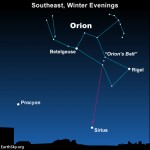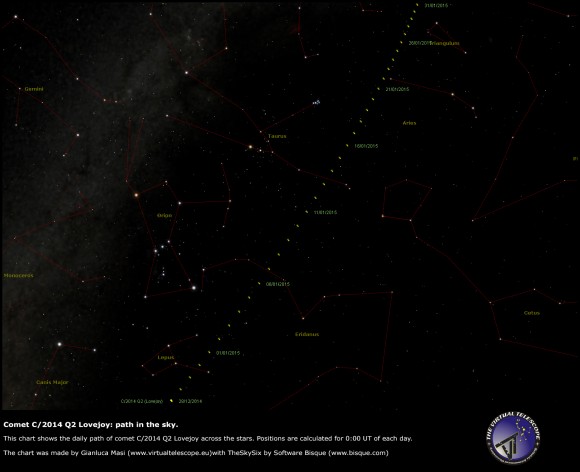
Tonight, look for the two Dog Stars. The brighter of the two is Sirius, which makes up the neck of the constellation Canis Major, the Greater Dog. Sirius is easy to spot, because it also happens to be the brightest of all the stars we see in our night sky. The other Dog Star is Procyon in the constellation Canis Minor the Lesser Dog. Procyon means “before the Dog” because this star’s rising signals that Sirius, the Dog star, is soon to follow Procyon into the sky.
There’s a comet in the sky now that you can see with binoculars. In fact, if the moon weren’t so bright now, you might be able to see this comet with your eye, under exceptionally good sky conditions. Doesn’t matter. Dust off the binoculars and try to see Comet Lovejoy! At the moment, it’s not far in the sky from the stars Sirius and Procyon. Click here to see photos and get more info about Comet Lovejoy.
Donate: Your support means the world to us

View larger. | Chart via Virtual Telescope Project. Join its live comet viewing on January 6 and 11.
Also bright in the sky, although less so than Sirius, is the star Adhara, which makes up the Larger Dog’s bottom right foot. Although it’s true that Sirius has the brightest apparent magnitude of all the visible stars, Adhara actually has a brighter absolute magnitude than Sirius. In other words, Sirius looks bright to us because it’s closer. But if the two stars were observed at an equal distance from Earth, Adhara would appear brighter than Sirius.
Apparent magnitude is the measure of brightness of a star as seen from Earth at the star’s natural distance. Absolute magnitude is the measure of the brightness of a star as seen from Earth if the star were placed at a distance of 32.6 light-years from the Earth. So, while Sirius may be the brighter star, this is not because it is intrinsically more luminous. It is because Sirius is much closer to the Earth than Adhara.
Sky chart of the constellation Canis Major the larger Dog

View Larger Orion’s Belt, the compact line of three stars at the upper right, points to the star Sirius, the Dog star.
Bottom line: If you’re in the Northern Hemisphere, and you look towards the southeast tonight in late evening, you’ll find Sirius, the brightest star in the sky. Sirius is also the brighter of the two Dog Stars. It is said to represent the neck of the constellation Canis Major, the Greater Dog. The other Dog Star is nearby Procyon, in the constellation Canis Minor the Lesser Dog. Also in this part of the sky … Comet Lovejoy. Click here to find out more about the comet.
Live by the moon with your 2015 EarthSky lunar calendar!
Rising times of Procyon and Sirius into your sky
from EarthSky http://earthsky.org/tonight/find-dog-stars-on-december-late-evenings

Tonight, look for the two Dog Stars. The brighter of the two is Sirius, which makes up the neck of the constellation Canis Major, the Greater Dog. Sirius is easy to spot, because it also happens to be the brightest of all the stars we see in our night sky. The other Dog Star is Procyon in the constellation Canis Minor the Lesser Dog. Procyon means “before the Dog” because this star’s rising signals that Sirius, the Dog star, is soon to follow Procyon into the sky.
There’s a comet in the sky now that you can see with binoculars. In fact, if the moon weren’t so bright now, you might be able to see this comet with your eye, under exceptionally good sky conditions. Doesn’t matter. Dust off the binoculars and try to see Comet Lovejoy! At the moment, it’s not far in the sky from the stars Sirius and Procyon. Click here to see photos and get more info about Comet Lovejoy.
Donate: Your support means the world to us

View larger. | Chart via Virtual Telescope Project. Join its live comet viewing on January 6 and 11.
Also bright in the sky, although less so than Sirius, is the star Adhara, which makes up the Larger Dog’s bottom right foot. Although it’s true that Sirius has the brightest apparent magnitude of all the visible stars, Adhara actually has a brighter absolute magnitude than Sirius. In other words, Sirius looks bright to us because it’s closer. But if the two stars were observed at an equal distance from Earth, Adhara would appear brighter than Sirius.
Apparent magnitude is the measure of brightness of a star as seen from Earth at the star’s natural distance. Absolute magnitude is the measure of the brightness of a star as seen from Earth if the star were placed at a distance of 32.6 light-years from the Earth. So, while Sirius may be the brighter star, this is not because it is intrinsically more luminous. It is because Sirius is much closer to the Earth than Adhara.
Sky chart of the constellation Canis Major the larger Dog

View Larger Orion’s Belt, the compact line of three stars at the upper right, points to the star Sirius, the Dog star.
Bottom line: If you’re in the Northern Hemisphere, and you look towards the southeast tonight in late evening, you’ll find Sirius, the brightest star in the sky. Sirius is also the brighter of the two Dog Stars. It is said to represent the neck of the constellation Canis Major, the Greater Dog. The other Dog Star is nearby Procyon, in the constellation Canis Minor the Lesser Dog. Also in this part of the sky … Comet Lovejoy. Click here to find out more about the comet.
Live by the moon with your 2015 EarthSky lunar calendar!
Rising times of Procyon and Sirius into your sky
from EarthSky http://earthsky.org/tonight/find-dog-stars-on-december-late-evenings

Aucun commentaire:
Enregistrer un commentaire